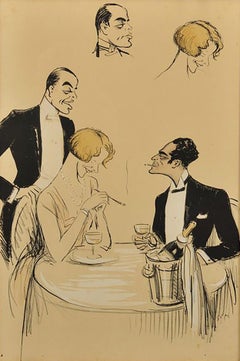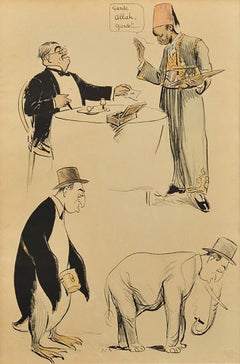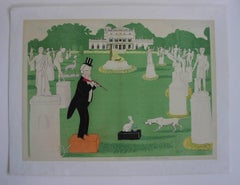George Goursat Art
to
3
2
2
1
2
1
Overall Height
to
Overall Width
to
3
2
2
1
1
1
1
2
1
1
5
6,910
3,236
2,514
1,217
2
2
2
1
Artist: George Goursat
Political Cartoon
By George Goursat
Located in Fort Washington, PA
Medium: Pen and Ink on Board
Signature: Signed Lower Right
A political cartoon of a man and a woman at a dinner table.
Category
Late 19th Century George Goursat Art
Materials
Board, Pen, Ink
Muslim Waiter Collecting Bill
By George Goursat
Located in Fort Washington, PA
Medium: Pen and Ink on Board
Signature: Signed Lower Right
This work is a political cartoon of a Muslim waiter collecting a bill.
Category
Early 19th Century George Goursat Art
Materials
Board, Ink, Pen
Ouverture de la Chasse ua Bois de Boulogne
By George Goursat
Located in New York, NY
Sem, (George Goursart). Ouverture de la Chasse ua Bois de Boulogne..
Ca 1900. Signed in the stone. Slight center vertical fold, otherwise in
very good condition.
Signed in the sto...
Category
Early 1900s Art Nouveau George Goursat Art
Materials
Lithograph
Related Items
The Abduction of the Sabine Women , a Renaissance drawing by Biagio Pupini
Located in PARIS, FR
This vigorous drawing has long been attributed to Polidoro da Caravaggio: The Abduction of the Sabine Women is one of the scenes that Polidoro depicted between 1525 and 1527 on the façade of the Milesi Palazzo in Rome. However, the proximity to another drawing inspired by this same façade, kept at the Ecole des Beaux-Arts, and to other drawings inspired by Polidoro kept at the Musée du Louvre, leads us to propose an attribution to Biagio Pupini, a Bolognese artist whose life remains barely known, despite the abundant number of drawings attributed to him.
1. Biagio Pupini, a Bolognese artist in the light of the Roman Renaissance
The early life of Biagio Pupini, an important figure of the first half of the Cinquecento in Bologna - Vasari mentions him several times - is still poorly known. Neither his date of birth (probably around 1490-1495) nor his training are known. He is said to have been a pupil of Francesco Francia (1450 - 1517) and his name appears for the first time in 1511 in a contract with the painter Bagnacavallo (c. 1484 - 1542) for the frescoes of a church in Faenza. He then collaborated with Girolamo da Carpi, at San Michele in Bosco and at the villa of Belriguardo.
He must have gone to Rome for the first time with Bagnacavallo between 1511 and 1519. There he discovered the art of Raphael, with whom he might have worked, and that of Polidoro da Caravaggio. This first visit, and those that followed, were the occasion for an intense study of ancient and modern art, as illustrated by his abundant graphic production.
Polidoro da Caravaggio had a particular influence on the technique adopted by Pupini. Executed on coloured paper, his drawings generally combine pen, brown ink and wash with abundant highlights of white gouache, as in the drawing presented here.
2. The Abduction of the Sabine Women
Our drawing is an adaptation of a fresco painted between 1525 and 1527 by Polidoro da Caravaggio on the façade of the Milesi Palace in Rome. These painted façades were very famous from the moment they were painted and inspired many artists during their stay in Rome. These frescoes are now very deteriorated and difficult to see, as the palace is in a rather narrow street.
The episode of the abduction of the Sabine women (which appears in the centre of the photo above) is a historical theme that goes back to the origins of Rome and is recounted both by Titus Livius (Ab Urbe condita I,13), by Ovid (Fasti III, 199-228) and by Plutarch (II, Romulus 14-19). After killing his twin brother Romus, Romulus populates the city of Rome by opening it up to refugees and brigands and finds himself with an excess of men. Because of their reputation, none of the inhabitants of the neighbouring cities want to give them their daughters in marriage. The Romans then decide to invite their Sabine neighbours to a great feast during which they slaughter the Sabines and kidnap their daughters.
The engraving made by Giovanni Battista Gallestruzzi (1618 - 1677) around 1656-1658 gives us a good understanding of the Polidoro fresco, allowing us to see how Biagio Pupini reworked the scene to extract this dynamic group.
With a remarkable economy of means, Biagio Pupini takes over the left-hand side of the fresco and depicts in a very dense space two main groups, each consisting of a Roman and a Sabine, completed by a group of three soldiers in the background (which seems to differ quite significantly from Polidoro's composition).
The balance of the drawing is based on a very strongly structured composition. The drawing is organised around a median vertical axis, which runs along both the elbow of the kidnapped Sabine on the left and the foot of her captor, and the two main diagonals, reinforced by four secondary diagonals. This diamond-shaped structure creates an extremely dynamic space, in which centripetal movements (the legs of the Sabine on the right, the arm of the soldier on the back at the top right) and centrifugal movements (the arm of the kidnapper on the left and the legs of the Sabine he is carrying away, the arm of the Sabine on the right) oppose each other, giving the drawing the appearance of a whirlpool around a central point of support situated slightly to the left of the navel of the kidnapper on the right.
3. Polidoro da Caravaggio, and the decorations of Roman palaces
Polidoro da Caravaggio was a paradoxical artist who entered Raphael's (1483 - 1520) workshop at a very young age, when he oversaw the Lodges in the Vatican. Most of his Roman work, which was the peak of his career, has disappeared, as he specialised in facade painting, and yet these paintings, which are eminently visible in urban spaces, have influenced generations of artists who copied them abundantly during their visits to Rome.
Polidoro Caldara was born in Caravaggio around 1495-1500 (the birthplace of Michelangelo Merisi, known as Caravaggio, who was born there in 1571), some forty kilometres east of Milan. According to Vasari, he arrived as a mason on the Vatican's construction site and joined Raphael's workshop around 1517 (at the age of eighteen according to Vasari). This integration would have allowed Polidoro to work not only on the frescoes of the Lodges, but also on some of the frescoes of the Chambers, as well as on the flat of Cardinal Bibiena in the Vatican.
After Raphael's death in 1520, Polidoro worked first with Perin del Vaga before joining forces with Maturino of Florence (1490 - 1528), whom he had also known in Raphael's workshop. Together they specialised in the painting of palace façades. They were to produce some forty façades decorated with grisaille paintings imitating antique bas-reliefs.
The Sack of Rome in 1527, during which his friend Maturino was killed, led Polidoro to flee first to Naples (where he had already stayed in 1523), then to Messina. It was while he was preparing his return to the peninsula that he was murdered by one of his assistants, Tonno Calabrese, in 1543.
In his Vite, Vasari celebrated Polidoro as the greatest façade decorator of his time, noting that "there is no flat, palace, garden or villa in Rome that does not contain a work by Polidoro". Polidoro's facade decorations, most of which have disappeared as they were displayed in the open air, constitute the most important lost chapter of Roman art of the Cinquecento. The few surviving drawings of the painter can, however, give an idea of the original appearance of his murals and show that he was an artist of remarkable and highly original genius.
4. The façade of the Milesi Palace
Giovanni Antonio Milesi, who commissioned this palace, located not far from the Tiber, north of Piazza Navona, was a native of the Bergamo area, like Polidoro, with whom he maintained close friendly ties. Executed in the last years before the Sack of Rome, around 1526-1527, the decoration of Palazzo Milesi is considered Polidoro's greatest decorative success.
An engraving by Ernesto Maccari made at the end of the nineteenth century allows us to understand the general balance of this façade, which was still well preserved at the time. The frescoes were not entirely monochrome, but alternated elements in chiaroscuro simulating marble bas-reliefs and those in ochre simulating bronze and gold vases...
Category
16th Century Old Masters George Goursat Art
Materials
Ink, Gouache, Pen
"Lorenzaccio" by Alphonse Mucha from Les Maitres de l'Affiche
By Alphonse Mucha
Located in Hinsdale, IL
Alphonse Mucha
"Lorenzaccio, a play in five acts and an epilogue by Alfred de Museet"
Plate #114
Image Size: 15" x 11"
1896
Alphonse Mucha was born in Southern Moravia on July 24, 1860. At the age of seventeen the artist left his home, to work as a painter of stage decorations...
Category
1890s Art Nouveau George Goursat Art
Materials
Lithograph
H 23 in W 14.5 in D 1 in
Odalisque
By Jolanta Johnsson
Located in Boxholm, SE
Jolanta Johnsson, experienced Polish artist, graduate of the Academy of Fine Arts in Warsaw, PhD of fine arts, university teacher. She currently lives in Sweden.
This is how she writes about the drawing:
In my intimate drawings, I capture what is closest to me – the private moments that I would hardly want to reveal. And yet, I choose to share them with my audience.
The motif of the odalisque, a reclining woman, has long been a popular subject in art. Throughout history, numerous artists have embraced this theme, and some of their paintings depicting reclining women have become iconic, shaping the course of art in their respective eras. Art historians have extensively written about the influence of these works. Notably, the odalisques created by the French painter Jean-Auguste-Dominique Ingres, such as his renowned piece “La Grande Odalisque...
Category
1990s Contemporary George Goursat Art
Materials
Ink, Pen, Acrylic
Inbetweeners
By Jolanta Johnsson
Located in Boxholm, SE
Jolanta Johnsson, experienced Polish artist, graduate of the Academy of Fine Arts in Warsaw, PhD of fine arts, university teacher. She currently lives in Sweden.
This is how she writ...
Category
1990s George Goursat Art
Materials
Pen, Acrylic, Ink
Black and White Situation
By Jolanta Johnsson
Located in Boxholm, SE
Jolanta Johnsson, experienced Polish artist, graduate of the Academy of Fine Arts in Warsaw, PhD of fine arts, university teacher. She currently lives in Sweden.
This is how she writ...
Category
1990s Contemporary George Goursat Art
Materials
Ink, Acrylic, Pen
Jonas Wood 24 Tennis Court Drawings book (signed with 3 hand drawn tennis balls)
By Jonas Wood
Located in New York, NY
Jonas Wood 24 Tennis Court Drawings book (hand signed with hand drawn tennis balls), 2021
Hardback monograph with signed and dated tennis ball drawing
Signed and dated with 3 balls d...
Category
2010s Contemporary George Goursat Art
Materials
Lithograph, Board, Offset, Permanent Marker, Mixed Media
H 13.5 in W 9.25 in D 0.4 in
'At the Fruit Stand', Market Scene with Vendors, Mother and Child
Located in Santa Cruz, CA
Signed lower right, 'Stuart Miller' (American, 20th Century) and painted circa 1965.
Category
1960s American Modern George Goursat Art
Materials
Paper, Gouache, Board, Pen
H 20.25 in W 15.5 in D 0.25 in
Bacchantes and Musicians - Original Lithograph by Ferdinand Bac - 1922
Located in Roma, IT
Bacchantes and Musicians is an original modern artwork realized by Ferdinand Bac (1859 - 1952) in 1923.
Signed and dated on plate on the lower left corn...
Category
1920s Art Nouveau George Goursat Art
Materials
Lithograph
H 7.49 in W 5.52 in D 0.04 in
Original French early 20th Century Theatre poster of 'Le Reve'
By Théophile Alexandre Steinlen
Located in Petworth, West Sussex
Le Reve (The dream)
An original theatre poster designed by Theophile Alexandre Steinlen for Le Reve at the Academie Nationale de Musique
96 x 76cm. (incl. frame)
New white wood fram...
Category
Early 20th Century Art Nouveau George Goursat Art
Materials
Lithograph
H 37.8 in W 29.93 in D 0.79 in
Veiled Woman - Original Lithograph by Ferdinand Bac - 1922
Located in Roma, IT
Veiled Woman is an original modern artwork realized by Ferdinand Bac (1859 - 1952) in 1922.
Signed and dated on plate on the lower left corner: F. Bac 19...
Category
1920s Art Nouveau George Goursat Art
Materials
Lithograph
H 11.42 in W 8.47 in D 0.04 in
Adolphe Willette Lithograph Original Hand Signed Seven Deadly Sins Erotic Nude
By Adolphe Willette
Located in FR
Adolphe Willette Lithograph Original Hand Signed 'Le Banquet' erotic No 95
Well known for his version of The Seven Deadly Sins
Adolphe Léon Willette ...
Category
1910s Art Nouveau George Goursat Art
Materials
Lithograph
Unique Cloud Drawing, hand signed, dated and inscribed to Caroline, in monograph
By KAWS
Located in New York, NY
KAWS
Unique Cloud Drawing, inscribed to Caroline
Original drawing done in silver marker.
Hand signed, inscribed and dated. Held in hardback monograph
11 × 8 3/4 inches
Boldly hand s...
Category
2010s Street Art George Goursat Art
Materials
Mixed Media, Board, Permanent Marker, Offset
H 11 in W 8.75 in D 1 in
George Goursat art for sale on 1stDibs.
Find a wide variety of authentic George Goursat art available for sale on 1stDibs. You can also browse by medium to find art by George Goursat in board, ink, pen and more. Not every interior allows for large George Goursat art, so small editions measuring 13 inches across are available. Customers who are interested in this artist might also find the work of Eugène Delâtre, Adolfo Hohenstein, and Aleardo Terzi. George Goursat art prices can differ depending upon medium, time period and other attributes. On 1stDibs, the price for these items starts at $1,450 and tops out at $2,200, while the average work can sell for $2,200.




